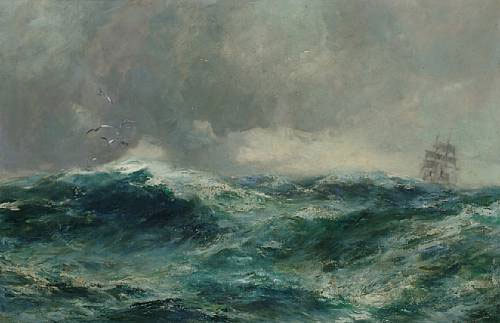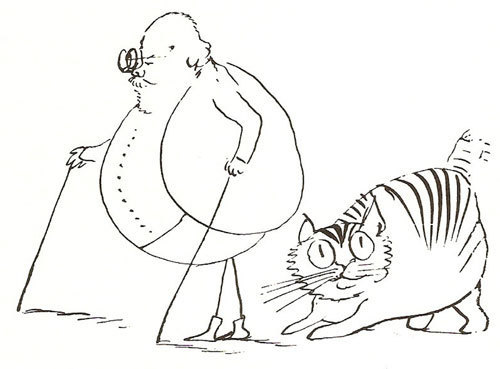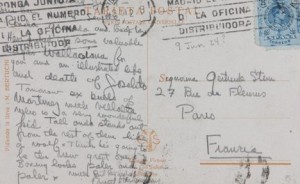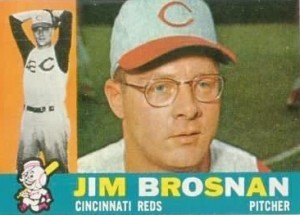The Paris Review's Blog, page 878
October 29, 2012
(Topical) Poem of the Day
The Hurricane
Lord of the winds! I feel thee nigh,
I know thy breath in the burning sky!
And I wait, with a thrill in every vein,
For the coming of the hurricane!
And lo! on the wing of the heavy gales,
Through the boundless arch of heaven he sails;
Silent and slow, and terribly strong,
The mighty shadow is borne along,
Like the dark eternity to come;
While the world below, dismayed and dumb,
Through the calm of the thick hot atmosphere
Looks up at its gloomy folds with fear.
They darken fast; and the golden blaze
Of the sun is quenched in the lurid haze,
And he sends through the shade a funeral ray—
A glare that is neither night nor day,
A beam that touches, with hues of death,
The clouds above and the earth beneath.
To its covert glides the silent bird,
While the hurricane’s distant voice is heard,
Uplifted among the mountains round,
And the forests hear and answer the sound.
He is come! he is come! do ye not behold
His ample robes on the wind unrolled?
Giant of air! we bid thee hail!—
How his gray skirts toss in the whirling gale;
How his huge and writhing arms are bent,
To clasp the zone of the firmament,
And fold at length, in their dark embrace,
From mountain to mountain the visible space.
Darker—still darker! the whirlwinds bear
The dust of the plains to the middle air:
And hark to the crashing, long and loud,
Of the chariot of God in the thunder-cloud!
You may trace its path by the flashes that start
From the rapid wheels where’er they dart,
As the fire-bolts leap to the world below,
And flood the skies with a lurid glow.
What roar is that?—’tis the rain that breaks
In torrents away from the airy lakes,
Heavily poured on the shuddering ground,
And shedding a nameless horror round.
Ah! well known woods, and mountains, and skies,
With the very clouds!—ye are lost to my eyes.
I seek ye vainly, and see in your place
The shadowy tempest that sweeps through space,
A whirling ocean that fills the wall
Of the crystal heaven, and buries all.
And I, cut off from the world, remain
Alone with the terrible hurricane.
—William Cullen Bryant, 1854
Painting Credit B.F. Gribble, Clipper in Stormy Sea, nd, oil
Edward Lear’s Cat
He has many friends, lay men and clerical,
Old Foss is the name of his cat;
His body is perfectly spherical,
He weareth a runcible hat.
Two thousand twelve marks Edward Lear’s bicentenary year. The author is known for many things: his nonsense verse, his nature art, his letters. If you’ve spent any time with the letters—and if you have, you know they’re utterly delightful—you are familiar with Lear’s faithful feline companion, Foss. A regular presence, both in word and sketch, Foss, who was adopted by the Lear family as a tabby kitten in 1873, was one of the constants in the author’s life.
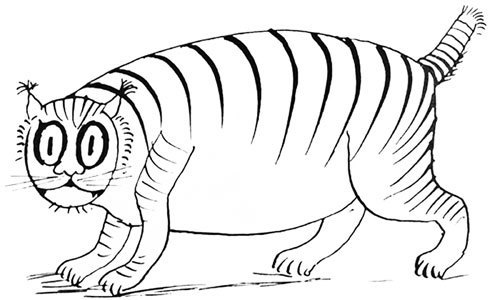
As we know from Lear’s numerous illustrations, Foss had only half a tail: legend has it, a servant chopped it off, in the superstitious belief that this would keep him from straying.Read More »
Happy Birthday, Ballpoint!
On this day in 1945, the first commercially-made ballpoint pens went on sale at New York’s late Gimbels Department Store for $12.50. The model, an unlicensed copy of an Argentine design, was produced by one Milton Reynolds. He called it the Reynolds Rocket, and we’ve been avoiding ink stains ever since. In its honor, watch how it’s made!
Urban Renewal: An Interview with Adrian Tomine
In “Missed Connection,” Adrian Tomine’s now-famous New Yorker cover illustration, a boy and a girl spot each other through the windows of subway cars headed in opposite directions. They’re both reading the same book—potentially perfect for each other, they’re destined not to meet. The image sums up what makes city life frustrating but also thrilling: the possibility of romance around every corner, the sense of isolation in a crowd, the higher-than-usual incidence of bookish hotties. Tomine began contributing crisp, colorful artwork to the magazine in 1999 and has continued to produce covers that often gently send up urban reading habits. The newly released New York Drawings collects the entirety of Tomine’s New Yorker work, along with his illustrations for other periodicals, book jackets, and album covers.
But commercial illustration is only one part of Tomine’s career. The thirty-eight-year-old artist began publishing comics as a teenager. His stories of young misfits and malcontents, serialized in his semiregular comic book, Optic Nerve, have been collected in book form as Sleepwalk and Other Stories, Summer Blonde, and a full-length graphic novel, Shortcomings. His short, funny, loose autobiographical comic strips pop up throughout his books; last year’s Scenes from an Impending Marriage narrated Tomine’s wedding preparations in the style of classic newspaper funnies.
A West Coast native, Tomine moved to Brooklyn eight years ago. We met one evening at a pastry shop near his home in Park Slope.
It seems obvious that by now your New Yorker work has given you more visibility than your comics. How do you feel about that?
It definitely reaches a broader audience. At this point there are a lot of people who know me through The New Yorker and have no idea about the comics I do. I guess that shouldn’t be surprising to me. I’ve separated the two jobs in my mind quite a bit, and that’s been useful. I’m sometimes a cartoonist and there’s an audience for that, and I’m sometimes an illustrator and there’s an audience for that.
But there must be some relationship between the two.
Chaucer Invented the Word Tweet, and Other News
Geoffrey Chaucer “provides our earliest ex. of twitter, verb: of a bird: to utter a succession of light tremulous notes; to chirp continuously.” See this, and his other contributions to language, on this handy-dandy word cloud.
Garcia Marquez takes Mexico City! (He already lives there, but the city is celebrating fifty years of calling Gabo a son with some forty thousand posters.)
This flowchart outlines how to publish a book (and makes it look so easy and colorful!).
William Faulkner and Woody Allen are in a feud. Okay, it’s actually the Faulkner Estate and Sony Pictures, which used a Faulkner quote in Midnight in Paris.
Happy birthday, American Antiquarian Society.
October 26, 2012
“The Tell-Tale Heart” in Pictures
“TRUE!—nervous—very, very dreadfully nervous I had been and am; but why will you say that I am mad?”
Daniel Horowitz takes on Poe’s classic 1843 tale of madness, paranoia, and murder.
“Now this is the point. You fancy me mad. Madmen know nothing. But you should have seen me. You should have seen how wisely I proceeded—with what caution—with what foresight—with what dissimulation I went to work!”


“Yes, he was stone, stone dead. I placed my hand upon the heart and held it there many minutes. There was no pulsation. He was stone dead. His eve would trouble me no more.”


“Was it possible they heard not? Almighty God!—no, no! They heard!—they suspected!—they knew!—they were making a mockery of my horror!–this I thought, and this I think. But anything was better than this agony! Anything was more tolerable than this derision! I could bear those hypocritical smiles no longer! I felt that I must scream or die! and now—again!—hark! louder! louder! louder! louder!”
Daniel Horowitz Brooklyn-based illustrator. His work has appeared in The New York Times, the Wall Street Journal, The Harvard Business Review, Time Magazine, and BusinessWeek.
What We’re Loving: Myth, Legend, Umlauts
A late-night note-to-self scribbled on the flyleaf of Rosemary Hill’s Stonehenge: “Why are you enraged by the idea of progress?” This short work of intellectual history—tracing theories of the megaliths from the seventeenth century to Spinal Tap—will have you reaching for the pencil on your own nightstand. It goes to the heart of English archaeology, architecture, religion, poetry, and politics, as various generations of eccentrics and savants struggle with the evidence of deep human time. By the end of the book, Stonehenge is more mysterious than ever, and so are the people who built it. In the words of David St. Hubbins, “No one knows who they were ... or what they were doing.” —Lorin Stein
Christine Schutt’s forthcoming novel, Prosperous Friends, is a story about marriage and sex and time in roughly the sense that Wheat Field with Cypress is a picture of a tree. Which is to say that execution is Schutt’s genius: I read her slowly, almost aurally, not out of any confusion or even by conscious choice but because her prose is the kind of euphonic I wish I could hum. —Samuel Fox
Read More »
Marilyn’s Books, Hemingway’s Vacation
Hemingway sent this postcard to Gertrude Stein from Spain in 1924.
A new version of “A Visit from Saint Nicholas” has removed all references to Santa’s pipe.
Just when you think you are too jaded to enjoy any more book arts and crafts … this.
Happy Saint Crispin’s Day.
Jonathan Franzen’s essay “House for Sale” has been adapted into a play and opened off-Broadway this week.
Marilyn Monroe’s bookshelf.
October 25, 2012
Quit Thinking, You’re Hurting the Club
In game six of last year’s World Series, with the Texas Rangers one strike away from clinching the franchise’s first championship, Lance Berkman, the St. Louis Cardinals’ aged first baseman whose thick physique and round face had earned him the nickname “Fat Elvis,” lined an inside fastball into shallow right-center, plating the tying run from second base. Even though he had just fulfilled the childhood fantasy of nearly everyone playing and watching the game that night by rescuing his team from World Series defeat, Berkman betrayed little emotion. Instead, he stoically slipped off his batting gloves and leaned in to listen to the instructions of the first-base coach, as if it were yet another humdrum hit in his distinguished career.
Until David Freese lofted a walk-off home run to center in the eleventh inning, Berkman remained in a state of what appeared to be Zen-like empty-headedness, his posture relaxed but attentive, his expressions varying little with each pendulous momentum shift. It was as though he were the only person in Busch Stadium who failed to comprehend the magnitude of the moment. When asked afterward what he was thinking about during his do-or-die at-bat in the tenth inning, Berkman simply replied, “Nothing.” This answer reinforced a central point in David Foster Wallace’s essay “How Tracy Austin Broke My Heart”:
It is not an accident that great athletes are often called ‘naturals,’ because they can, in performance, be totally present: they can proceed on instinct and muscle memory and autonomic will such that agent and action are one … The real, many-veiled answer to the question of just what goes through a great player’s mind as he stands at the center of hostile crowd-noise and lines up to the free-throw that will decide the game might well be: Read More »
Swimming Upstream: A Memoir in Pools
Because I loved the water and because I moved all the time—in search of what, I wasn’t yet sure—I found that swimming laps was a good way to get somewhere without booking another ticket. Wherever we were, I’d search out an open lane, and sometimes I’d surprise myself, encountering the person who emerged on the other side. You could learn a lot with your eyes closed.
Way back, before we moved to the Middle East, I loved the thrill of swimming at Hamilton Fish, the big outdoor pool on East Houston Street, where the Europeans swam fast in skimpy suits, but where there was always plenty of room for everyone. We lived nearby, in Chinatown, and I rode my bike a few blocks to my first big editor job. We were young and it was hard to imagine anything going wrong.
Then my wife got the fellowship in D.C., which sent her to southern Russia, where she was detained for three days by Russian authorities, who took her passport, laptop, and notes, and then threatened to take her to trial in Chechnya. When she landed in Virginia, her friends and I were relieved and waved little American flags. Later, recuperating at a hotel near Dupont Circle, she and I swam laps at the National Capitol YMCA, on Rhode Island Avenue, but all the other swimmers were super aggressive—with as many as ten to a lane, shouldn’t these august people have known better?—and I found the crush of writhing bodies too exhausting ever to go back.
The Paris Review's Blog
- The Paris Review's profile
- 305 followers


